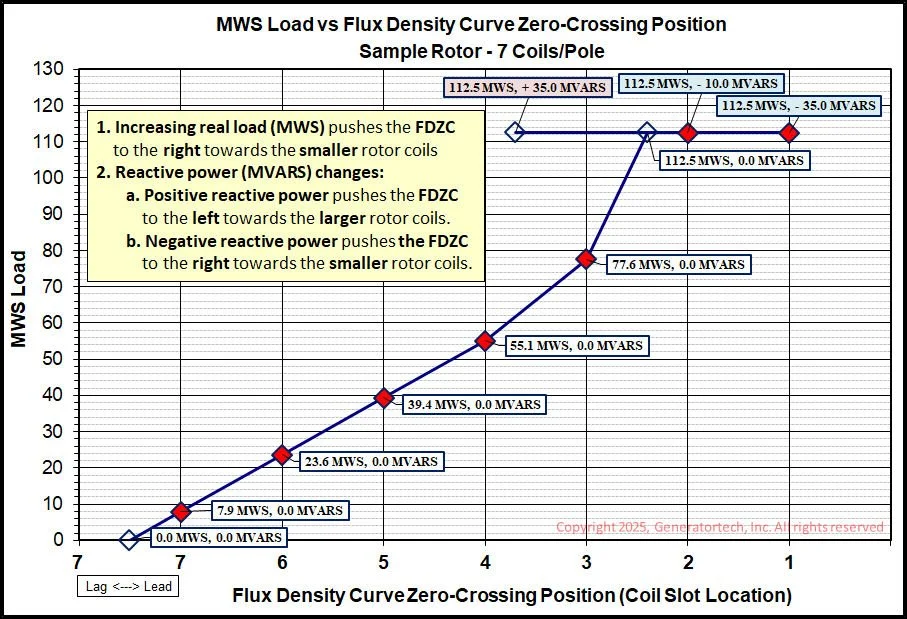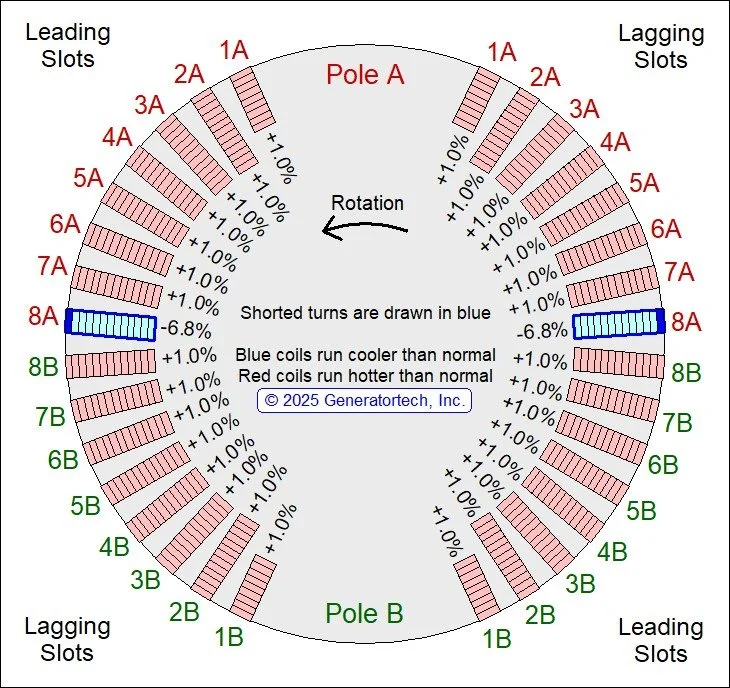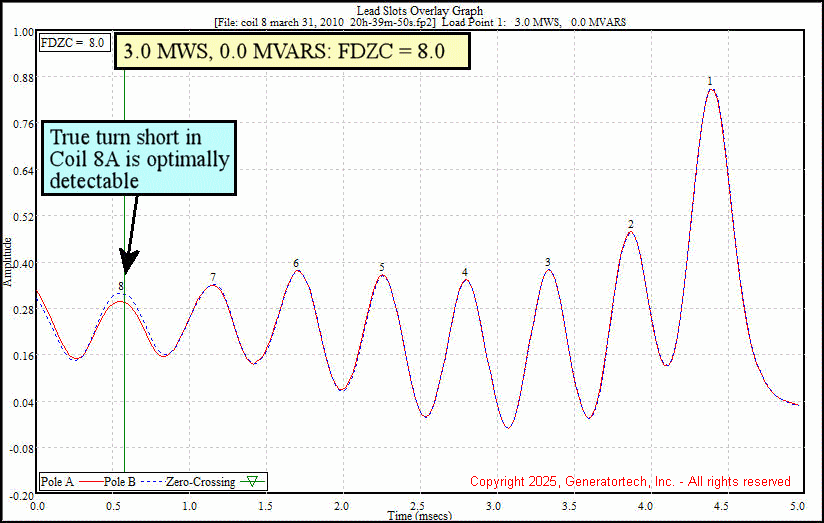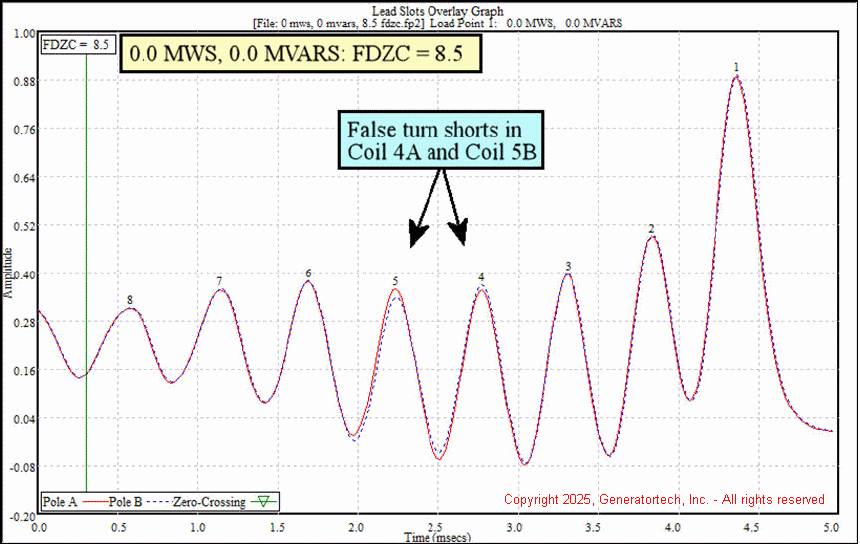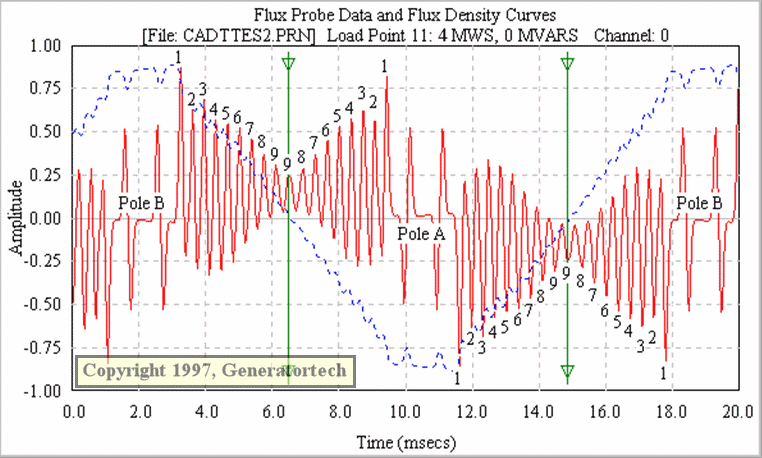Need for Recording a Wide Range of Loads
Flux probe waveform analysis performs a pole-to-pole comparison of coil slot peak heights in order to detect turn shorts. True turn short detection sensitivity varies with load, so testing at a single load can easily miss a real short in some coils. Detecting true turn shorts in all rotor coils requires a wide range of loads to be recorded. In addition, peak height differences unrelated to turn shorts are common and these effects produce false turn short indications.. It is impossible to differentiate true and false turn short indications if data is only recorded at a single load. Fortunately, true and false turn short indications respond oppositely to changes in load, so recording data over a wide range of loads insures the no true turn shorts are missed and that no false turn shorts are reported.
A given load in a synchronous generator produces a waveform with a flux density zero-crossing (FDZC) position that falls within the leading coil slots on the rotor. Higher real loads (MWS) push the FDZC position to the right towards the smaller rotor coils (Coils 1 and 2). At a given real load (MWS), reducing positive reactive power (MVARS) will also push the FDZC position to the right. The MWS Load vs FDZC Position Graph below show how both real and reactive load changes affect the FDZC position in a unit with a 7 Coils/Pole rotor.
There are two important benefits when the FDZC position is aligned with a given coil slot:
1. True turn short indications are maximized for that coil
2. False turn short indications are minimized for that coil
An optimum data set would include waveforms whose FDZC positions were aligned with each rotor coil slot. This insures that no true shorts will be missed and that no false turn short indications will be reported. The Generatortech software will automatically record optimized waveforms as load on the generator is changing.
MWS Load vs FDZC Position Graph - An optimum test would record a set of waveforms whose FDZC positions closely aligned with each rotor coil (red filled data points). Negative MVARs are often needed at full real load to align with the FDZC position with the smallest rotor coils (Coils 1 and 2). Generatortech software automatically records these optimized waveforms as load is changing.
Recording data using a narrow range of loads and not considering the FDZC position will produce both false negative and false positive indications. We have seen many examples of competitors’ reports that had errors of both types and at least a couple of rotor rewinds were planned that were based upon false turn short indications.
The two case studies shown below illustrate both types of errors in two identical 120 MVA generators at the same power plant. These were two-pole rotors with 8 coils/pole using 9 turns in Coil 1 and 13 turns in Coils 2-8.
Case 1 - False negative:
One true turn short existed in Coil 8-Pole A (Coil 8A). Testing at above 25% of full load could not detect the Coil 8A short, while low load testing clearly detected the short. Testing at only full load missed the short in Coil 8A. This rotor had no significant false turn short indications.
Case 2 - False positives:
At both low and high loads, false turn short indications were seen in Coil 4 and Coil 5. At medium loads, where the FDZC position was close to alignment with those coils, the false turn short indications disappeared. Testing at only full load falsely reported shorts in Coil 4B and Coil 5A.
Although the pattern of false turn short indications remains constant for a given rotor, even rotors from identical generators show different false turn short patterns. In the example below, the first rotor had no significant false turn short indications and the second rotor had two coils with significant false turn short indications. Therefore, false turn short indications cannot be predicted for a given generator. Only by recording a wide range of loads can indications be correctly categorized as true or false.
Case 1: Rotor Cross-Section of a 2-pole rotor with 8 Coils/Pole showing the location of a true short in Coil 8A. Competitor’s testing at full load falsely claimed the rotor was free of turn shorts.
Case 1: Lead Slots Overlay Graph Animation - the single short in Coil 8A was not detectable at loads higher than about 25% of full load. However, the short was obvious in low load waveforms. True turn short indications are maximized in waveforms whose FDZC positions are close to alignment with the affected coil.
Case 2: Rotor cross-section showing no true shorts. The false turn short indications seen in Coils 4 and 5 at both low and high loads are modulation artifacts and will not impact normal operation. Competitor’s testing at full load falsely claimed the rotor winding had two shorts.
Case 2: Lead Slots Overlay Graph Animation - the false short indications in Coil 4 and Coil 5 were seen in both low and high loads. In medium loads, where the FDZC positions were closer to alignment with those coils, the false indications disappeared. False indications are minimized in waveforms whose FDZC positions are close to alignment with the affected coil.
Modulation Effects on Coil Slot Peak Heights
Pole-to-pole peak size comparisons are used to locate turn shorts in a coil, so contributions to peak height that are unrelated to turn shorts will reduce detection sensitivity. The goal of testing over a wide range of loads is to minimize effects on peak size other than from the active turns in a coil.
The rotor slots have a much higher magnetic reluctance than the iron making up the rotor body and the magnetic field directly above each slot will be lower than the field above the iron on either side. This reluctance-induced change in field strength across the slot is the modulation effect. Modulation effects increase the peak height associated with a coil slot, but they do not reflect number of active turns in the coil. This reduces the true turn short detection sensitivity of the coil. Modulation effects are proportional to the magnetic field around the coil slot, with higher magnetic fields producing stronger modulation effects. The coil that is aligned with the flux density zero-crossing (FDZC) position will minimize modulation effects since there is very little field to modulate.
Pole-to-pole differences in peak heights that are not related to turn shorts produce false turn short indications. Most false turn short indications are related to pole-to-pole differences in modulation effects. Therefore, most false turn short indications will be minimized or disappear when the FDZC position is aligned with the affected coils (see Case 2 above).
The figure below shows a series of waveforms recorded from a temporary flux probe that had been intentionally positioned too close to the rotor surface in order to emphasize how modulation effects can dominate peak heights. For a given coil, its peak height is a minimum when it is aligned with the FDZC position (smallest magnetic field, dotted blue curve). At that point, there is very little field to modulate and the peak height is almost entirely due to the rotor slot leakage flux produce by the coil. Since rotor slot leakage flux is proportional to the number of active turns in the coil, its measurement is key to determining turn shorts. Away from the FDZC position, the field gets stronger, and the modulation effect produces larger and larger peak heights. Note the large peaks in the pole faces that are due to amortisseur winding slots. The amortisseur slots are not carrying any current in these waveforms, so their peak sizes are 100% modulation effects.
Modulation Effects on Peak Heights - This test was performed with a temporary flux probe intentionally adjusted too close to the rotor surface in order to emphasize modulation effects on coil slot peak heights. For a given coil, the peak size will be at a minimum when the FDZC (vertical green line) is aligned with that coil. The peak size of coils far from the FDZC are mostly due to modulation effects, reducing detection sensitivity for true shorts.


